Anywhere is Everywhere:
Recaliming Community through production in the Rural Northeast
by Khristopher Flack
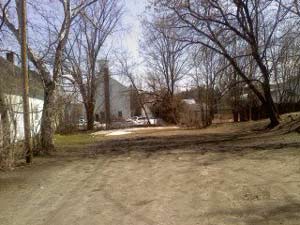
A lot in Newport Vermont before communalization
“Hey! What are you doing in my backyard?”
We looked up to Zack, a stout 5 year old with a buzzed mohawk, blue t shirt, and gym shorts, squinting at us through the morning sun with his hands on his hips. All winter we’d been betting our vision of a new community garden, fresh food access, and a neighborhood hub on whatever was beneath the snow. We’d been told by everyone from city officials to neighbors that no matter how perfect it looked on a Newport City map, the mud lot in the middle of a residential block off of Main St. was at once a drug den, a boxing ring, a litter box, and a parking lot. For us, this was the charm and the challenge, in the same category as gardening in Vermont, a few miles from Canada. So even while we were picking up spark plugs, single socks, wire hangers and other litter on this chilly May morning, our answer to Zack seemed as simple as his question.
“We’re making a garden…”
“What kind of garden?”
He started walking toward us, confused.
“Probably a vegetable garden, but it’ll have lots of flowers and other things too.”
“Why are you making a garden?”
“Why not?”
“I don’t know…”
“Do you want to help?”
The responses we got from Zack and the neighbors proved that the community that we as artists and designers hoped to grow through the new garden already existed in a more vibrant, complex form than anyone knew. There was already a deeply evolving network of friendships. There were already informal economies and a hunger to prove this neighborhood better than its rumors. There was a fairly broad knowledge of gardening. This muddy hole in the heart of the neighborhood was the amplifier for all of these assets that was missing, and over the next few months, we relinquished our roles as community artists to the neighborhood itself, treating its collective story as the most meaningful work of modern art worth working on.
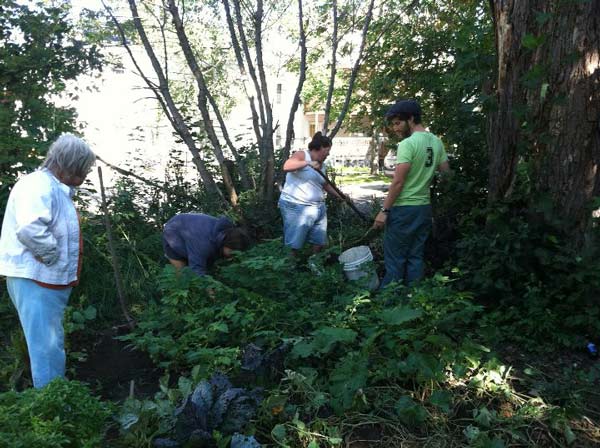
Harvesting and Composting, Community Garden, Newport Vermont
The work in progress that’s come of it is Fresh Start Community Farm: a 6,000 sq. ft. garden and playground hosting 40 gardeners, a native seed saving project, a “story fence” depicting the neighborhood’s oral history, and enough surplus food to sell at the independent market down the block. Zack and his friends have a safe place to play. With the help of grant funds from the state, Brenda Ashman went from unemployed mother to a paid Garden Manager with business cards. Crime in the neighborhood has dropped. We’ve hosted a street fair, workshops, and community cookouts. Conversations about next year are already stirring, with ambitions of opening additional gardens on unused city land that could serve as an incubator for young farmers, all working toward a decentralized, diversified community farm of pocket parks and urban gardens scattered around the city.
Yet despite these successes, Newport still isn’t a place many of its 5,000 citizens would call modern, if only because of the bruises modernity and progress have left here. Like most towns built on industries that came and went decades ago, many folks in Newport are mired in a default identity that’s stuck between the skepticism of those who repeat its most apparent shortcomings and the majority of the world that doesn’t know Newport exists. There is a collective expectation that nothing new or innovative will happen here, and if it does, it will happen to us. Although modernity often touts being ahead of time, most of us here find ourselves left in the meantime, waiting to find out what comes next.
But the more I sink into the momentum of the garden, the more walking down Main Street becomes like walking through a living, movable diorama of our own modernity, each empty storefront offering invisible evidence that we can and must unsubscribe from a generic future and craft our own.
After being expected to hold our breaths through the budget debate, the debt ceiling debate, and the whims of the stock market to see if our lives can continue or not, we are realizing—as millions across the country are realizing—that our sense of community and whatever's inside each of us personally is the most capable engine for generating dependable, fresh steps forward. These are some of the only things that can't be borrowed, borrowed against, speculated on, lost, sold, or turned into a derivative. As such, there is nothing to lose. The dream of “modern society” or “the modern world” has proven itself not only disappointing and unattainable, but insultingly impersonal. Let these old paradigms stagnate or not. We are redefining modernity as the reclamation and revaluing of our everyday lives and the fundamental acts which compose them: growing and eating food, working together, creating something local to us that can coexist or be independent of “The World.” By cultivating this place-based modernity, we simultaneously assume a new meaning of modernity and let go of the concept altogether.
In this choice we find the power and autonomy of localized living. Yet unlike the back to the land movement, the autonomy cultivated by grassroots modernism is a byproduct, not the priority. Rather than retreating from the community to a refugee camp for likeminded people, the grassroots modernist sees him or herself as part of an intentional community already, and insists on calibrating those intentions to confront the challenge of staying put, refusing to be chased from his or her community by the threats of failing systems. By mustering the courage to initiate the transformations we want to see, and forging a progressive, local agenda with what’s available, we each find ourselves enjoying a sense of autonomy as part of a community, without having had to dissolve the community and separate to find it.
As we’re transcending previous concepts of communal living we’re also embracing cooperation that transcends specialization and old enemies by creating new friendships. The land for Fresh Start is owned by the most notorious landlord in the city, who no one expected to support a project like ours before we approached him; the Mayor himself couldn’t believe we wanted to “give a garden to those people.” But as the ones who traditionally do not profit from the divisions between The Powerful and The Powerless, it’s in our best interest to assume our own power and prove to traditionally dominant parties that there are ways forward that benefit everyone. The landlord was happy to have a garden in a lot that couldn’t be developed any other way; the Mayor, regardless of how he feels about the neighborhood, is no doubt happy about all the positive attention the garden has brought to the city. The same is true across the community, where the city planner's time is worth as much as the time of the neighbor who manages the garden and the artist’s technical expertise is enhanced by the neighbor’s insight. In a climate of grassroots modernism, “The Man” is de-capitalized maybe so, maybe no. Is this the best word?, joining everyone else on the pavement, where we find a mutual interest in shifting from The Powerful vs. The Powerless to a more nuanced, joint identity as The Empowered.
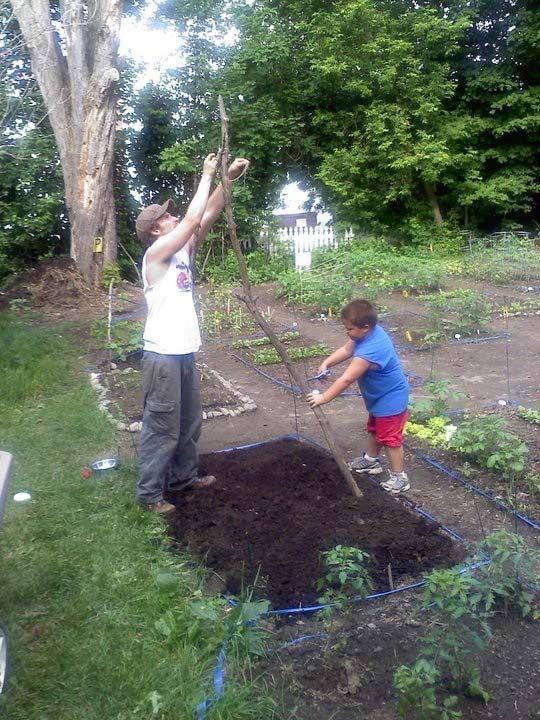
Khris and Zak work the garden.
And so, our innovation isn’t really in our projects —community gardens, collective living, and art aren’t new. Our innovation is in adapting our highest, most creative aspirations to the needs of our particular place and insisting to ourselves and each other that those aspirations can be the basis of viable lives. Accordingly, grassroots modernity needs no authorization or endorsement. It happens organically, as soon as we realize our ability to reclaim our everyday lives, as a handful of us in Newport are trying to reclaim a 20x10 patch of grass at the end of Eastern Avenue to plant a few berry bushes, a ½ acre in the shadow of the water tower to grow veggies, 5,000 square feet of lawn across the street from a lawnmower repair shop for pear trees.
But grassroots modernity is destined for the graveyard of manifestoes if it finds itself culturally owned—and eventually dropped— by the Austins, Portlands, Brooklyns, and West Phillys of the world. There are no capitals of the country we are looking to create, and in some sense, there is no country. There is no President of the United States to heave all our hopes on, or all our disappointment; there is no Congress or Senate to be frustrated with. My heart does not plunge when the stock market plunges. My worth and the worth of my ambitions and my potential do not fluctuate with the dollar. We are looking to create individual communities and clusters of communities that innovate ways to meet their specific needs and ambitions, who relate to one another the way people ideally would, as different, unique beings with unique skills and passions, with a set of core, mutually understood values. And if we are serious about working toward the spread of this way of living on a global or even regional scale, then we all have to learn to see the evolutionary potential in wherever we are right now, or at least consider bringing our energies and ideas to places that no one would expect to carry the banner of any major or minor movement. All the time, friends ask me “Why Newport? These are great ideas, but don’t you think they’d be better off elsewhere?” Newport is elsewhere and it is also anywhere, and by changing anywhere, change everywhere will come.
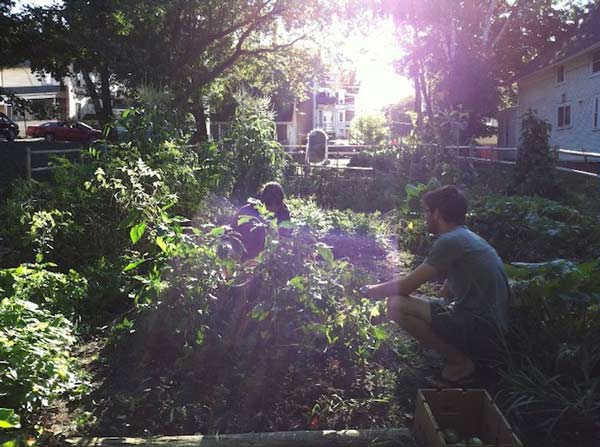
Harvest Time
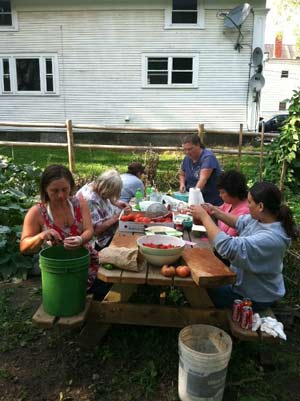
Making Salsa, Newport Vermont